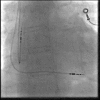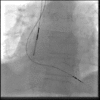Chest pain following permanent pacemaker insertion… a case of pneumopericardium due to atrial lead perforation
- PMID: 30366893
- PMCID: PMC6203003
- DOI: 10.1136/bcr-2018-226318
Chest pain following permanent pacemaker insertion… a case of pneumopericardium due to atrial lead perforation
Abstract
Permanent pacemaker (PPM) implantation is an increasingly common procedure with complication rate estimated between 3% and 6%. Cardiac perforation by pacemaker lead(s) is rare, but a previous study has shown that it is probably an underdiagnosed complication. We are presenting a case of a patient who presented 5 days after PPM insertion with new-onset pleuritic chest pain. She had a normal chest X-ray (CXR), and acceptable pacing checks. However, a CT scan of the chest showed pneumopericardium and pneumothorax secondary to atrial lead perforation. The pain only settled by replacing the atrial lead. A repeat chest CT scan a few months later showed complete resolution of the pneumopericardium and pneumothorax. We believe that cardiac perforation can be easily missed if associated with normal CXR and acceptable pacing parameters. Unexplained chest pain following PPM insertion might be the only clue for such complication, although it might not always be present.
Keywords: Cardiovascular Medicine; Pacing And Electrophysiology.
© BMJ Publishing Group Limited 2018. Re-use permitted under CC BY-NC. No commercial re-use. See rights and permissions. Published by BMJ.
Conflict of interest statement
Competing interests: None declared.
Figures




Similar articles
-
Pan pneumo: an unusual complication following pacemaker implantation.BMJ Case Rep. 2024 Jun 26;17(6):e260860. doi: 10.1136/bcr-2024-260860. BMJ Case Rep. 2024. PMID: 38926126
-
Pneumopericardium and pneumothorax due to right atrial permanent pacemaker lead perforation.J Med Imaging Radiat Oncol. 2015 Feb;59(1):74-6. doi: 10.1111/1754-9485.12200. Epub 2014 Jul 1. J Med Imaging Radiat Oncol. 2015. PMID: 24980040
-
Pneumopericardium with cardiac tamponade as a complication of cardiac pacemaker insertion one year after procedure.J Emerg Med. 2012 Oct;43(4):641-4. doi: 10.1016/j.jemermed.2010.04.026. Epub 2010 Jun 12. J Emerg Med. 2012. PMID: 20542397
-
Pericardial effusion and right-sided pneumothorax resulting from an atrial active-fixation lead.Europace. 2003 Oct;5(4):419-23. doi: 10.1016/s1099-5129(03)00079-5. Europace. 2003. PMID: 14753641 Review.
-
Delayed lead perforation: a disturbing trend.Pacing Clin Electrophysiol. 2005 Mar;28(3):251-3. doi: 10.1111/j.1540-8159.2005.40003.x. Pacing Clin Electrophysiol. 2005. PMID: 15733190 Review.
Cited by
-
A Case of Contralateral Pneumothorax, Pneumomediastinum, and Pneumopericardium after Dual-Chamber Pacemaker Implantation.Case Rep Cardiol. 2022 Dec 3;2022:4295247. doi: 10.1155/2022/4295247. eCollection 2022. Case Rep Cardiol. 2022. PMID: 36510573 Free PMC article.
-
EHRA expert consensus statement and practical guide on optimal implantation technique for conventional pacemakers and implantable cardioverter-defibrillators: endorsed by the Heart Rhythm Society (HRS), the Asia Pacific Heart Rhythm Society (APHRS), and the Latin-American Heart Rhythm Society (LAHRS).Europace. 2021 Jul 18;23(7):983-1008. doi: 10.1093/europace/euaa367. Europace. 2021. PMID: 33878762 Free PMC article.
-
Atrial lead perforation early after device implantation-a case report and literature review.Front Surg. 2024 Apr 5;11:1290574. doi: 10.3389/fsurg.2024.1290574. eCollection 2024. Front Surg. 2024. PMID: 38645506 Free PMC article.
References
-
- The 11th annual report for the National Cardiac Rhythm Management Devices Audit, April 2015 – March 2016, published on 14th February, 2017. http://www.ucl.ac.uk/nicor/audits/cardiacrhythm/documents/annual-reports....
-
- Dai Y, Chen KP, Hua W, et al. . [Retrospective analysis on the clinical features and management of acute and subacute right ventricular perforation by pacemaker lead]. Zhonghua Xin Xue Guan Bing Za Zhi 2013;41:862–5. - PubMed
Publication types
MeSH terms
LinkOut - more resources
Full Text Sources
Medical
